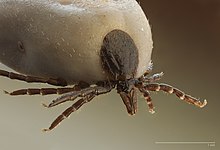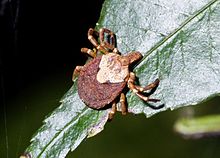| Ixodidae Temporal range: Cretaceous–present PreꞒ Ꞓ O S D C P T J K Pg N | |
|---|---|

| |
| Ixodes ricinus (engorged) | |
| Scientific classification | |
| Domain: | Eukaryota |
| Kingdom: | Animalia |
| Phylum: | Arthropoda |
| Subphylum: | Chelicerata |
| Class: | Arachnida |
| Order: | Ixodida |
| Superfamily: | Ixodoidea |
| Family: | Ixodidae C. L. Koch, 1844 |
The Ixodidae are the family of hard ticks or scale ticks, one of the three families of ticks, consisting of over 700 species. They are known as 'hard ticks' because they have a scutum or hard shield, which the other major family of ticks, the 'soft ticks' (Argasidae), lack. They are ectoparasites of a wide range of host species, and some are vectors of pathogens that can cause human disease.
Description
They are distinguished from the Argasidae by the presence of a scutum. In both the nymph and the adult, a prominent gnathosoma (or capitulum, mouth and feeding parts) projects forward from the animal's body; in the Argasidae, conversely, the gnathosoma is concealed beneath the body.
They differ, too, in their lifecycle; Ixodidae that attach to a host bite painlessly and are generally unnoticed, and they remain in place until they engorge and are ready to change their skin; this process may take days or weeks. Some species drop off the host to moult in a safe place, whereas others remain on the same host and only drop off once they are ready to lay their eggs.
Classification

There are 702 species in 14 genera. The family contains these genera:
- Africaniella – 2 species
- Amblyomma – 130 species (includes some of Aponomma)
- Anomalohimalaya – 3 species
- Archaeocroton – 1 species
- Bothriocroton – 7 species
- Cosmiomma – 1 species
- Cornupalpatum – 1 species
- Compluriscutula – 1 species
- Dermacentor – 34 species (includes Anocentor)
- Haemaphysalis – 166 species
- Hyalomma – 27 species
- Ixodes – 246 species
- Margaropus – 3 species
- Nosomma – 2 species
- Rhipicentor – 2 species
- Rhipicephalus – 82 species (includes Boophilus)
- Robertsicus – 1 species
Fossil genera
- †Compluriscutula Poinar and Buckley 2008 Burmese amber, Myanmar, Cenomanian
- †Cornupalpatum Poinar and Brown 2003 Burmese amber, Myanmar, Cenomanian
Medical importance
See also: Tick-borne diseaseMany hard ticks are of considerable medical importance, acting as vectors of diseases caused by bacteria, protozoa, and viruses, such as Rickettsia and Borrelia. Other tick-borne diseases include Lyme disease, babesiosis, ehrlichiosis, Rocky Mountain spotted fever, anaplasmosis, Southern tick-associated rash illness, tick-borne relapsing fever, tularemia, Colorado tick fever, Powassan encephalitis, and Q fever.
See also
References
- "Ixodidae". NCBI taxonomy. Bethesda, MD: National Center for Biotechnology Information. Archived from the original on 14 May 2018. Retrieved 28 September 2017.
Lineage( full ) cellular organisms; Eukaryota; Opisthokonta; Metazoa; Eumetazoa; Bilateria; Protostomia; Ecdysozoa; Panarthropoda; Arthropoda; Chelicerata; Arachnida; Acari; Parasitiformes; Ixodida; Ixodoidea
- ^ D. H. Molyneux (1993). "Vectors". In Francis E. G. Cox (ed.). Modern parasitology: a textbook of parasitology (2nd ed.). Wiley-Blackwell. pp. 53–74. ISBN 978-0-632-02585-5. Archived from the original on 2017-02-15. Retrieved 2016-11-06.
- ^ Alberto A. Guglielmone; Richard G. Robbing; Dmitry A. Apanaskevich; Trevor N. Petney; Agustín Estrada-Peña; Ivan G. Horak; Renfu Shao; Stephen C. Barker (2010). "The Argasidae, Ixodidae and Nuttalliellidae (Acari: Ixodida) of the world: a list of valid species names" (PDF). Zootaxa. 2528: 1–28. doi:10.11646/zootaxa.2528.1.1. hdl:11336/97869. Archived (PDF) from the original on 2019-07-24. Retrieved 2015-06-28.
- "CDC - Tick-Borne Diseases - NIOSH Workplace Safety and Health Topic". www.cdc.gov. 2018-11-14. Archived from the original on 2019-07-01. Retrieved 2019-07-01.
External links
- [REDACTED] Data related to Ixodidae at Wikispecies
- [REDACTED] Media related to Ixodidae at Wikimedia Commons
| Acari (ticks and mites) | |||||||||
|---|---|---|---|---|---|---|---|---|---|
| Acariformes |
|  | |||||||
| Parasitiformes |
| ||||||||